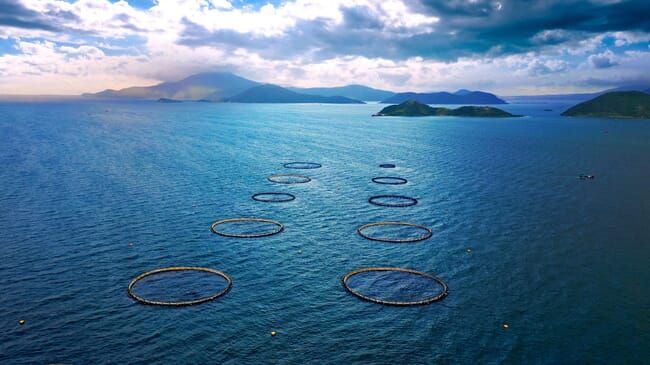
Effective, efficient mariculture operations also have the benefit of requiring only a small amount of space; according to the study, typically 3 percent or less of a country’s exclusive economic zone is required to meet consumer demand © Australis Aquaculture
So argues an international collaboration of researchers, in a new paper, published in the journal Nature, who look at the potential of a warming ocean to satisfy the growing global appetite.
“Climate change will challenge the ability for the ocean to meet the seafood demands of a growing population,” said Christopher Free, a researcher at the UC Santa Barbara and lead author of the paper, in a press release. “However the ocean could produce more food than today through swift and ambitious actions.”
Currently providing only 17 percent of the world’s protein supply, most of it from capture fisheries, the ocean holds great potential to help satisfy the global demand for meat, which is expected to keep growing – especially as developing countries grow richer.
But it’s also subject to global greenhouse gas emissions, which results in effects such as warming and acidification – phenomena that are expected to decrease the ocean’s ability to meet the seafood demands of a growing population.
“Warming waters are changing where fish can live, what prey they can eat, and how well they can survive,” said Free. “Both fishers and fisheries managers have to adapt to these changes.”
Fisheries can maintain or increase their yields by adapting their practices to shifts in the productivity and location of their fish stocks, the researchers said. However, these reforms alone, though necessary, will be insufficient to fulfill future demand. Finfish and shellfish farms will be essential to fill that gap.
“Expansion of sustainable ocean aquaculture could build on fisheries reforms to increase the availability of healthy and sustainable seafood to our growing population,” said Halley Froehlich, an assistant professor at UC Santa Barbara and co-author of the paper. According to the study, the expansion of mariculture is projected to be limited by consumer demand or availability of feed ingredients derived from wild fisheries, rather than by climate change. With the appropriate selection of species and location, for example, the researchers found that “the availability of area for profitable finfish mariculture to be insensitive to changing temperature, oxygenation and salinity.”
Additionally, because food production by its nature generates impacts to the environment, the sustainable expansion of mariculture must be conducted carefully.
“It will require improved governance to ensure best practices that minimize impacts on ocean ecosystems and encourage equitable access to this growing industry,” said Willow Battista, a senior manager at the Environmental Defense Fund and also a co-author on the paper.
What this sweet spot of governance looks like will vary by location. In highly regulated geographies such as the United States, mariculture regulations may need to be more well defined to allow sustainable mariculture to grow. In weakly regulated regions, such as China or Thailand, standards will have to be maintained to prevent inefficiencies and ecosystem degradation. Regions where little or no historical mariculture production exists, as in many of the African nations expected to be hardest hit by climate change, will have to invest in training and infrastructure.
More efficient aquaculture
Effective, efficient mariculture operations also have the benefit of requiring only a small amount of space; according to the study, typically 3 percent or less of a country’s exclusive economic zone is required to meet consumer demand.
“The small space requirement for mariculture leaves ample room for careful planning to minimize impacts on other ocean industries,” said Steve Gaines, dean of the Bren School and a co-author on the paper. With careful coordination, mariculture operations can be set up so as not to compete with fisheries, coastal tourism and shipping, among other ocean industries.
In fact, its efficiency is one of mariculture’s key advantages: it has a lower greenhouse gas footprint and lower demands for water and land than many land-based sources of meat. And with improvements to finfish feed, breeding and husbandry, it is possible to further increase yield to meet consumer demand. According to the researchers, gearing food production toward the ocean could not only satisfy the growing global appetite for meat, it could also free up land required for terrestrial agriculture.
“Shifts in consumer preferences away from terrestrial meat could reduce the environmental impacts of global food systems,” Froehlich said. With an increase in production, prices are expected to decrease, allowing access to local, sustainable and nutritious food.
Producing food from the ocean for future populations will no doubt take a global concerted effort. But nowhere is it more urgent than in tropical developing countries, places where climate driven productivity loss, coupled with growing populations, put a great strain on food security.
“Tropical developing countries will endure the greatest losses in fisheries catches and may therefore be priorities for investments in ocean aquaculture expansion,” said Reniel Cabral, a senior lecturer at James Cook University and co-author on the study.




